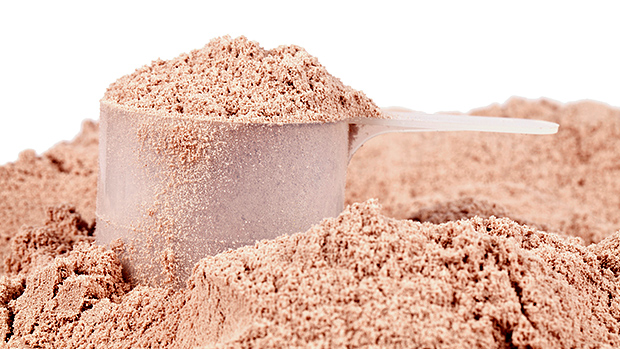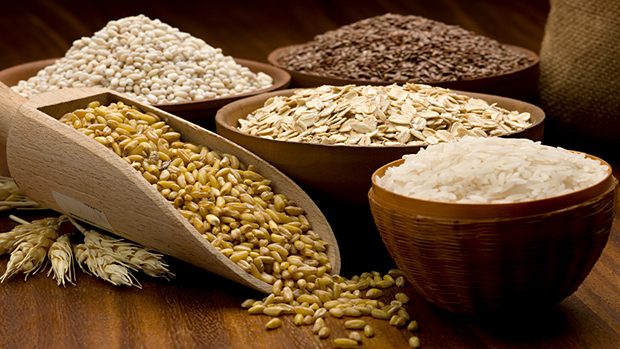The Question
What's the biggest health food imposter?
Butter and bacon
People are obsessed with butter and bacon. It's understandable since they're delicious, but I don't see any grounds for considering them health foods the way many people do.
This claim comes from the recent influx in data showing that restricting saturated fat might not be as beneficial for heart health as we once thought, especially if you're replacing the fat with simple carbs (like all the SnackWells cookie lovers did for so many years).
But somehow this information has been translated to "eat copious amounts of butter, bacon, and saturated fat because it's good for you." C'mon now.
You'll be hard pressed to find data that supports the overeating of these foods. A 2014 study found that people with diabetes eating PUFA (polyunsaturated fatty acids) vs. SFA (saturated fatty acids) lead to improvements in lean mass.
The sensible approach? Aim to get one-third of your total fat intake from saturated sources (bacon, butter, etc), one-third from monounsaturated sources (beef, olive oil, macadamia nuts), and one-third from poly unsaturated sources (salmon, nuts, etc).
This means that you can have bacon and butter but don't think they're health foods. And don't think you'll benefit from them by adding a significant amount to your diet on top of what you're already eating. – Mike Roussell, PhD
Most organic foods
One of the biggest misconceptions, and a huge contributor to poor health and lousy physiques, is the belief that anything labeled "organic" is automatically a good choice for any diet plan. That's simply not the case. Soda made with organic cane juice is still soda. Organic jelly-filled toaster pastries are still jelly-filled toaster pastries. Organic mac 'n cheese is still freaking macaroni and cheese.
"Organic" has precisely zero to do with the amount of calories or macros a food contains, so in that sense, you're better off pretending the word doesn't exist.
Can some organic foods be a better choice than conventional? Yep, definitely, but that's largely due to fewer pesticides and other potential toxins. It has nothing really to do with organic foods automatically having more protein, less sugar, or fewer calories than their non-organic counterparts.
You're fooling yourself, not to mention wasting time and lots of money, if you think you're going to drop more body fat by snacking on the highly processed, carb and fat-loaded organic potato chips instead of the highly processed, carb and fat-loaded non-organic potato chips.
Go organic where you can or where it makes the most healthful impact – things like fatty protein sources, fruits, vegetables, and coffee. And instead of opting for organic versions of junk food, maybe try a wacky idea like skipping the junk entirely. – Chris Colucci
Bogus bars
Protein bars have long been abused by marketers and food technologists. They often include low-biological value, terribly incomplete proteins, like collagen and gelatin, which are high in the ingredients' list. They can be stuffed with laxative-levels of sugar alcohols, and they regularly include various junk food-esqe components to make them seem appealing.
It's ironic: A product that's sold as a health food can be so damn fake and unhealthy. From poor support of protein synthesis to gas and diarrhea, I'm just not seeing what's so healthy, especially for three dollars a bar. Better I think to retrain one's palate to not desire chocolate bars so desperately. Why not instead remember how delicious real foods are? A lot of my heroes growing up became amazing bodybuilders on staples like potatoes, brown rice, chicken and broccoli. They weren't so weak as to seek excuses to eat daily desserts.
Now, the relatively rare legitimate protein bar is indeed a convenient way to take whey and/or casein along with you. I just don't feel like we should follow the "gen pop" along the road of crutch foods without ever learning which ones deserve to be staples in the diet. – Lonnie Lowery, PhD
Almond milk
The concept behind commercial almond milk is great. Take some fantastic tasting, nutrient-dense nuts, pulverize them, and then add water so that you have a lactose and largely allergen-free alternative with which to soak your Fruity Pebbles.
Too bad the actual version of almond milk, at least the industrial version, holds only a whiff of the promise of the conceptual version.
Sure, almond milk manufacturers start off with some almonds, but an entire carton generally contains the amount of almonds that can be held by one tiny, arthritic and gnarled old-lady hand. This little-bitty serving of almonds is pulverized, but then the manufacturers filter out all the fiber because it would settle to the bottom and thus require that customers shake the carton and everybody knows that shaking is for losers.
Given that the number of almonds they used is so meager, manufacturers are then obliged to add in nutrients like calcium and Vitamin E so they can boast, "50% more calcium than milk," and "50% RDI of Vitamin E." Adding vitamins back in is flat-out misleading. You'd almost rather have them strap a strip of vitamin pills on the side of the carton and advise you to take one with every serving of their concoction.
Then there's the protein, or lack of it. A serving of almonds contains about 6 grams of protein, but a serving of typical almond milk contains only one gram. Now if you drank the entire carton, you'd get about 6 grams, but again that's what you'd get from a single serving of whole almonds.
Sugar's an issue, too. The "original" flavor almond milk has about 7 grams of added sugar per serving while most vanilla flavored varieties have about 16 grams of added sugar. Yeah, yeah, cow's milk has about 13 grams of sugar, too, but at least the cow put it there instead of Stanley from Akron who sometimes can't tell if the white stuff he finds in his bandana after his shift is powdered sugar or dandruff.
One more thing: Manufacturers have to add thickeners like carrageenan to almond milk because when you grind up a single serving of almonds and add 32 ounces of water, it has the pale, watery, unappetizing look of goat semen. Adding it is understandable, but some of these thickeners have been implicated in gastrointestinal inflammation.
People are getting wise to these shenanigans, though. Just this past December, Blue Diamond Growers settled a class action suit with consumers who got all uppity about the company using the words "All Natural" or "Natural" on their almond milk labels when their product was anything but.
As a result of the suit, Blue Diamond can no longer use the word "natural" or the American Heart Association's "heart check mark" symbol on the cartons. They're also prohibited from using an image of two hands full of almonds on the label. Disappointingly, the settlement didn't require them to replace the image with one of two hands full of bullshit.
To save lots of money and make something that's truly nutritious, make your own almond milk:
Ingredients
- 1 cup sliced almonds
- 3 cups water (plus extra for soaking almonds)
- 1 tablespoon honey or agave (if you're a wuss)
- 1 teaspoon vanilla extract
- Pinch of kosher salt
Directions
- Place sliced almonds in a bowl and cover them with water. Set aside at room temp for 1 to 12 hours.
- Drain almonds and rinse. Combine almonds, 3 cups water, vanilla, and salt in a blender. Blend until smooth (about 2 minutes).
- Serve as is. It should last about 5 days in the fridge. Remember to stir before serving. – TC Luoma
Soy products

Soy burgers, chicken-like soy patties and nuggets, soy milk, soy cheese, soy protein bars, and low-carb soy-filled cereal – there are so many products, you could practically live off it. Or at least you THINK you could live off of it... until one day you realize that your face and abdomen are chronically puffy from water retention, you've had a period for five straight weeks (yes 35 days), you can't stop crying for no reason, and you have a face full of zits. That was me.
And I should've known better because earlier that year one of my nutrition professors had taught us about phytoestrogens (phyto meaning plant, estrogens meaning estrogens). But even after learning about these compounds, I didn't connect the dots. What was happening in my body was a direct result of what was going into my mouth, and it took a long damn time to translate classroom lecture into real life application.
But soy-filled stuff can look pretty good on paper. According to the Nutrition Facts on their boxes, they contain tons of protein, lots of fiber, very few net carbs, not a lot of fat, and a huge bonus – you can prepare them in less than a minute. Seems like the perfect solution for someone who doesn't have time to cook. Good ol' Chef Microwave has got you covered along with all these pre-packed protein delights.
Granted, you can probably avoid the massive hormonal fiasco by choosing ONE soy thing instead of ten, and by sticking to a serving at a time. But why risk it if you know that even just a little may tinker with the hormones responsible for your mood, health, metabolism, and even sex life?
Obviously there are people who eat soy and live long, healthy lives. But we likely don't know the extent of what the processed stuff can do to our physiology. Years after my experience, I discovered a lot of information about soy from TC Luoma, John Berardi, and my husband, Chris, which gave me the affirmation I needed to avoid faux-meat forever.
There does seem to be an exception with soy consumption: the occasional serving of actual soy beans, called edamame. It's probably fine to indulge in these once in a while in reasonable serving sizes. – Dani Shugart
Adult breakfast cereals
You know that kiddie breakfast cereals are just love handles in a box, but "healthy" adult cereals are often just as bad, and sometimes even worse.
These cereals are lot like women you meet at clubs. The outside package looks fine, but look past the padded push-up bra, the Spanx, and the mental disorder she's temporarily suppressed with vodka tonics, and what's underneath is pretty scary.
Cereal manufacturers are masters of label loopholes. The FDA sets strict rules about nutrition and ingredient lists, but it's pretty easy to disguise the facts. For example, ingredient lists are supposed to list things in order of quantity: the first thing on the list should be the most prevalent ingredient.
Fit people know to avoid a packaged food if sugar is listed somewhere near the top of the list. But the fact is, most "healthy" cereals on the market should have sugar listed in the first or second spot. They don't.
How do they get away with it? By including several forms of sugar: organic cane syrup, cane crystals, evaporated cane juice, fruit juice concentrates, honey, African whoopie tree extract, unicorn tears, etc. That way they can break it up and list something like rolled oats at the top when it should be listed behind the real main ingredient: sugar.
What about the cereals with added protein? Well, it's usually the cheap stuff: soy. You know, the protein that's so junky that even quality dog food manufacturers now brag about not using it.
Then there are the calories. One popular brand of granola with several front-of-box health claims has 220 calories for half a cup. Go measure out half a cup of anything. That's a handful, maybe a few bites. Compare that to oatmeal, where you get a whole cup for about 150 calories.
Cereal makers are marketing their breakfast candy to people who want to be healthier, but also don't know much about nutrition and are too busy to read the back of the box closely. So these folks will probably eat a meal-sized bowl of that granola cereal, about 800 calories before adding milk.
So the nice lady trying to lose weight just had 1000 total calories for breakfast, probably more than half the calories she needs for the day to lose fat. "But, but, the cereal is brown! And it says it's 'heart healthy' right there on the box!" Sheesh.
One more label shenanigan: the "made with" trick. Yes, your twigs 'n leaves cereal is made with whole grains, but frog shit is "made with" natural fiber. Doesn't mean you should eat it. "Made with" is code word for "throw a pinch of something in there that average dopes think is healthy so we can brag about it on the box, then fill up the rest with the same crap we put in Captain Clowny's Kooky Krisps." Don't fall for it.
Now, confession time: I eat cereal. I get it at the health food store and it comes in a bag. It's puffed rice. It has one ingredient: rice. Nothing else. A full cup has 50 calories. (And by the way, it's dirt cheap.) For "milk" I use a scoop of Metabolic Drive® Protein mixed with ice-cold water. You can buy puffed corn like this too.

No, these cereals aren't quite as delightful as Honey-Cuckled Wheaty Flakes, but I prefer them to the pregnant-male look.
So, flip that box around and check the ingredient list closely. Never assume it supports your goals just because the manufacturer replaced the cartoon character with a leafy-green meadow. – Chris Shugart
Canola oil
The biggest health food imposter is polyunsaturated vegetable oils, specifically canola oil. Canola oil, otherwise known as rapeseed oil, that's been genetically modified, is a fraud.
Monsanto produces the vast majority of genetically engineered rapeseeds so they're resistant to Roundup (toxic herbicide), but that's just one concern. Typical processing methods for canola and other vegetable oils include chemicals and very high heat, which oxidizes the polyunsaturated fats and makes them rancid. Rancid oil leads to free radicals in the human body which in turn leads to inflammation. Inflammation is the source of all sorts of health issues including diabetes, cancer, and heart disease.
Furthermore, any appreciable amount of heart healthy omega-3 fatty acids found in canola oil are in the plant form, specifically alpha linolenic acid, that's nearly useless due to the human body's inefficiency at converting it to a useable form. Go eat wild caught salmon if you want omega-3s because the marketing on the heart healthy benefits of canola oil is a joke.
I distinctly recall the mainstream media praising trans-fats, otherwise known as trans-unsaturated fat, as heart healthy up until the late 90's. We now know the ruinous health results of trans-fats, which is why food manufacturers must eliminate its use completely by 2018. I suspect excessive polyunsaturated vegetable oils will be next once informed individuals begin to outnumber the lobbyists. Until that time, avoiding processed food is your best defense. – Mark Dugdale
Rice cakes
They're called "cakes" for a reason! They have a higher glycemic index than a wide number of desert foods. Just a reminder, the glycemic index is a measure of how fast a certain food raises blood sugar levels, which is also an indirect (but fairly accurate) evaluation of how much insulin will be released.
The superiority of low glycemic foods for body composition changes is pretty well established. And it's well known that if insulin is constantly kept high you'll be much more likely to store fat. Not to mention that insulin that's always high can have detrimental effects on health.
If you look at a commercial rice cake, its glycemic index is fairly high at around 85 (if eaten with nothing on it that would lower the glycemic load), compared to 40-60 for just rice and to 100 for pure sugar. To put things in perspective, it's also higher than pretty much all kids breakfast cereal. And that's for unflavored commercial rice cakes. The chocolate and caramel flavored ones are even higher than that!
Sure, each rice cake has a low caloric content, but they're also not very satisfying so you aren't likely to eat just one. Calories pile up.
Then the other issue is that rice cakes are pretty much devoid of nutritional value; very little if any vitamins and minerals, very little fiber (for the commercial rice cakes), etc. It's basically eating air, but air that provides calories and spikes blood sugar. And the thing with spiking blood sugar (and then insulin) is that soon after you will crave even more, which makes it hard to stick to your diet.
Yet many people who "eat healthy" include them in their diet. Well, let me break it down for you. Eating seven rice cakes would be as bad as eating one serving of Lucky Charms. Both will give you about the same caloric content and have a similar glycemic index. Scratch that, Lucky Charms actually contains some added vitamins and minerals, so rice cakes are actually worse. – Christian Thibaudeau
Organic anything
Even worse are the people who become smug about buying organic and are poorly educated, citing things like reduced pesticides as the reasoning behind buying organic. They're missing the glaring fact that there's a long list of exceptions by the USDA in regards to pesticides that can still be used. Organic pesticides are really no better in regards to health than non-organic pesticides.
The whole thing is a sham. And people still buy it. Just walk into a Whole Foods and you can smell the hippie smugness about "organic grass-fed wheat germ whole grain" goodness. Literally, you can smell it. All Whole Foods stores smell like man-buns and hipster smug. There's nothing healthier about organic food. – Paul Carter





